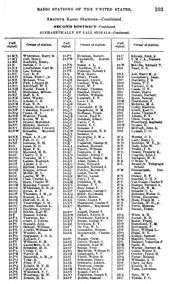Broadcast call signs
Broadcast call signs are call signs assigned as unique identifiers to radio stations and television stations. While broadcast radio stations will often brand themselves with plain-text names, identities such as "cool FM", "rock 105" or "the ABC network" are not globally unique. Another station in another city or country may (and often will) have a similar brand, and the name of a broadcast station for legal purposes is normally its internationally recognised ITU call sign. Some common conventions are followed around the world.
Broadcast stations in North America generally use call signs in the international series.
In the United States, the first letter generally is K for stations west of the Mississippi River (including Alaska, America Samoa, Guam, Hawaii, and Northern Mariana Islands) and W for those east of the Mississippi (including Puerto Rico and the Virgin Islands); all new call signs have been 4-character for some decades, though there are historical 3-character call letters still in use today, such as KSL in Salt Lake City and WGN in Chicago.
There are a number of exceptions to the east/west rule, such as KDKA in Pittsburgh and WFAA in Dallas-Fort Worth, but these are historical artifacts from a rule change in the 1920s, and most of the exceptions are located in the states immediately to either side of the river, in the state of Louisiana in the metropolitan areas of Baton Rouge and Greater New Orleans, and markets north of the river's source such as Fargo-Moorhead and Duluth-Superior. The westernmost station in the continental United States beginning with W is WOAI in San Antonio. WVUV-LP in Pago Pago, American Samoa, was the westernmost station with a W call sign until 2008. KYW in Philadelphia (which originated in Chicago in 1921, moved to Philadelphia in 1934, and existed in Cleveland in the late 1950s/early 1960s) is now the easternmost station with a K call sign.
Another exception to this is that all time-broadcasting stations have a three or four letter call sign beginning with WWV. The three current government-operated time stations, WWV (and longwave sister station WWVB), and WWVH, are located in Fort Collins, Colorado and Kekaha, Hawaii, respectively, both of which would normally use call signs beginning with "K". The US government-operated international broadcaster the Voice of America no longer has call signs assigned to it; however, Radio Canada International's transmitter in Sackville, NB is still assigned CKCX. Privately operated shortwave stations, like WWCR and CFRX, also have call signs.
In Canada, the publicly owned Canadian Broadcasting Corporation uses CBC Radio; privately owned commercial broadcast stations use primarily CF and CH through CK prefixes; and four stations licensed to St. John's by the Dominion of Newfoundland government retain their original VO calls.
In Mexico, AM radio stations use XE call signs (such as XEW-AM), while the majority of FM radio and television stations use XH. Broadcast call signs are normally four or five alpha characters in length, plus the -FM or -TV suffix where applicable.
In South America call signs have been a traditional way of identifying radio and TV stations. Some stations still broadcast their call signs a few times a day, but this practice is becoming very rare. Argentinian broadcast call signs consist of two or three letters followed by multiple numbers, the second and third letters indicating region. In Brazil, radio and TV stations are identified by a ZY, a third letter and three numbers. ZYA and ZYB are allocated to television stations, ZYI, ZYJ, ZYL and ZYK designate AM stations, ZYG is used for shortwave stations, ZYC, ZYD, ZYM and ZYU are given to FM stations.
In Australia, broadcast call signs are optional, but are allocated by the Australian Communications and Media Authority and are unique for each broadcast station. Most European and Asian countries do not use call signs to identify broadcast stations, but Japan, South Korea, Indonesia, the Philippines and Taiwan do have call sign systems. Britain has no call signs in the American sense, but broadcast stations are allowed to choose their own trade mark call sign up to six words in length.
Callbooks

A directory of radio station call signs is called a callbook. Callbooks were originally bound books that resembled a telephone directory and contains the name and addressees of licensed radio stations in a given jurisdiction (country). Modern Electrics published the first callbook in the United States in 1909.[1]
Today, the primary purpose of a callbook is to allow amateur radio operators to send a confirmation post card, called a QSL card to an operator who they have communicated via radio. Callbooks have evolved to include on-line databases that are accessible via the Internet to instantly obtain the address of another amateur radio operator and their QSL Managers. The most well known and used on-line QSL databases include QRZ.COM,[2] IK3QAR,[3] HamCall,[4] F6CYV,[5] DXInfo,[6] OZ7C[7] and QSLInfo.[8]
References
- ↑ Gernsback, H (May 1909). First Annual Official Wireless Blue Book of the Wireless Association of America (PDF). New York: Modern Electrics Publication. Retrieved 2010-11-24.
- ↑ "QRZ.COM". Retrieved 2010-11-24.
- ↑ "Qsl Manager - Qsl Info on-line". Retrieved 2010-11-24.
- ↑ "World Wide HamCall Callsign Server". Retrieved 2010-11-24.
- ↑ "QSL INFORMATION by F6CYV". Retrieved 2010-11-24.
- ↑ "DXInfo, your DX web resource". Retrieved 2010-11-24.
- ↑ "QSL Search machine by OZ7C". Retrieved 2010-11-24.
- ↑ "QSLInfo". Retrieved 2010-11-24.